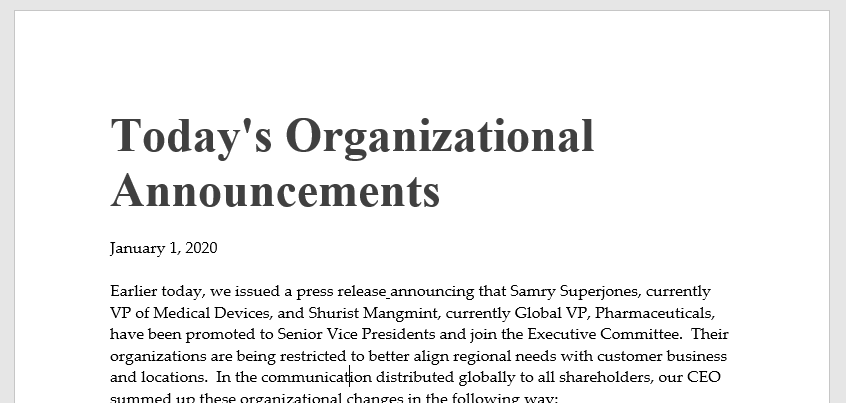by Dr. Dale J. Albrecht
© 2018, Alonos® Corporation
Executive Summary
This white paper examines some of the most common causes of repeated and unintentional re-organizations. These types of restructuring activities damage cultures, destroy employee engagement, and generate unnecessary change management issues. Like many things in business, laying the right foundation and starting out with business performance objectives helps to drive the entire effort.
Restructuring Again?
The announcement is out, and the company is re-organizing. The announcement goes on about who’s now reporting to whom, changes in duties, and the promotions of a lucky few. Your cube-neighbor pops into your space and says, “Didn’t we just re-org 8 months ago?” You respond, “Yeah, and 6 months before that too. I’ve been here 5 years, and we do this every year.” This kind of experience is common; too common in my opinion. Just about everyone who’s been in corporate for a few years has a story about repeated re-orgs.

I’ve been through many repeated re-org’s in my career. The failure rate of organizational structure changes has remained essentially unchanged for 40 years, hovering at 65-75%. Let’s reemphasize for clarity: that’s a failure rate. What this means for us is that 1 of every 3.5 working people will be impacted by failed organizational changes every year! That’s 42 million working people in the United States every year. What these statistics mean for us is that a failed organizational structure change is in your future; statistically, you will be impacted by org change failure every 42 months! Alarming, right?
The Top 5 Reasons
I’ve been consulting, advising, and facilitating organizational design for over 20 years. I have done hundreds of re-org’s. And, yes, I have unfortunately witnessed far too many failures. There are lessons that I have learned over the years that solve for the most common causes of failure:
1) Unclear business goals: Call me old fashioned if you want, but I firmly believe that there should be a clear business reason for organizational structure change. I’m not talking about goals for the organizational redesign, but goals for the business itself. Far too often organizational design projects focus on things like spans, layers, ratios, and communications. All potentially good discussion points, but none of which drive the business directly. As an alternative, use techniques such as the 5-why’s or other root cause analyses to trace the expressed need to true business goals that are measurable.
2) Wrong tool for the job: Unfortunately, organizational structure is often one of the first changes sought, even when it’s incomplete, or worst case, the wrong solution. There are seven disciplines that drive organizational capability. Organization design is one; the others are decision effectiveness, process design, systemization of work, tools, people, and incentives. Attributing the achievement of business goals solely to an organizational structure change is false thinking. There are always 2 or more disciplines that need to be invoked to achieve the results needed. To correct for this, step back and do a formal analysis, asking the question, “what else needs to be done to get the desired performance?” You will inevitably find inter-dependencies that need to be sequenced and planned in order for the entire effort to be successful.
3) Incomplete execution: This is connected to the previous item; even in case where the team does a good job of identifying the other work that needs to be done, failure to follow-through dooms the entire effort. Unfortunately, this is way too common. Going back to point #1, if the initiative is focused around an organizational change, then when the new structure is announced, everyone moves on and gets back to doing their jobs. The better approach is to orient around the business goal/performance, of which organizational design might be part of the answer. Then, fuller execution of all the work streams becomes essential to achieving the goals.
4) Too much, too fast: When organizational changes are substantial, it’s useful to take the time to define a phased implementation plan and the timing that would be used to get there. These phases should then be aligned with the work from the other disciplines that needs to be completed in order for the new structure to be effective.
5) Not going deep enough: If your organizational redesign addresses 1 or 2 levels, you’re likely not deep enough to impact performance. Inevitably, desired changes in effectiveness and efficiency require an examination of the activities, processes, roles, and structure, at the level where the work is performed. Key outputs of a sufficiently deep organizational design are revised work flows and job profiles.
Practiced Professionals
One additional piece of advice to improve your success rates: get help from a practiced professional. Like many things in our professional lives, being good at something requires on-going and regular practice. Even the best business leaders deal with organizational structure changes only periodically. Professionals in organizational design and business performance consulting deal with organizational designs every week of their careers. This makes them highly practiced. Professionals in this space bring with them tools, techniques, and expertise that ensure you’ll have higher success rates.
Recommended Citation:
Albrecht, D.J. (2018). The 5 Biggest Causes of Repeated Re-Org’s: Avoiding the re-organization pendulum (White Paper). Dallas, TX: Alonos Corporation. Retrieved from: alonos.com/resources
For further reading on this subject, pick up Dr. Albrecht’s book:
You can order it through major booksellers

